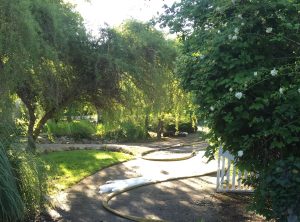As water shortages and water quality become the norm for California, many gardeners are turning to sustainable landscaping. Not only does sustainable landscaping promote water conservation and increased water quality, it is also low-maintenance, enhances soil quality, provides safe habitat for native wildlife and can even decrease energy usage.
Sustainable landscaping practices are interconnected and include careful plant selection and placement, effective watering, recycling of organic matter to improve soil and integrated pest management to reduce chemical use while attracting beneficial wildlife.
An important facet of sustainable landscaping is selecting plants best suited for your climate and microclimates. Generally speaking, the Sierra foothills are in Sunset’s climate Zone 7, bordering Zone 9 below Jamestown as you approach the San Joaquin Valley. In the higher elevations of Zone 7, gardeners will experience cooler, wetter microclimates.
Microclimates can vary throughout a garden depending on sun exposure, wind, soil type and even distance from asphalt. Choose plants that are native to your climate zone and thrive in nature in each of the different microclimates in your garden. Unlike exotics and invasive species, many California native plants are drought tolerant and, once established, help conserve water.
Plant placement is also key to sustainable landscaping. Group those with similar needs, allowing them to be cared for together. Native deciduous trees can be planted on southwest and southeast corners to increase shade in summer yet allow plenty of sun to reach the house in the winter. This promotes energy conservation. Grow ground covers near heat retentive surfaces such as asphalt to increase summer cooling.
Water conservation is another goal of sustainable landscaping. First and foremost, resist overwatering. Most of us overwater our plants (particularly those that are established) rather than waiting for the first signs of distress or checking the soil for dryness. Overwatering leads to runoff and losses to evaporation. Ultimately water and soil are both negatively affected as nutrients and other valuable soil materials are washed away in the water.
Drip irrigation applies water directly to a plant’s root zone, stimulating deeper root growth. With slow application, more water soaks in at deeper levels resulting in less evaporation on the surface. Another tactic is to use rainwater and or gray water to water trees and plants. Check local guidelines regarding use of gray water on edibles.
Amending your soil with organic material helps boost water-holding capacity, decreases runoff and enhances soil quality. Compost also improves soil texture and provides vital plant nutrients, reducing the need for fertilizer. Initially when planting, work compost deeply into the soil rather than applying it to just the top few inches. Thereafter to maintain good soil quality, till infrequently.
Adding three to four inches of mulch on top of your soil is a natural way to control weeds without the use of chemicals. Mulch also decreases evaporative losses and erosion and keeps material from heading to landfills.
Integrated pest management is key to sustainable landscaping. (IPM is the use of the least toxic methods for managing garden problems.) Limit the use of chemicals that have a negative effect on water and soil quality and are harmful to pollinators and other native wildlife.
Disease-resistant native plants attract beneficial wildlife to gardens which in turn keep pests at a minimum without pesticides. Mulch, rather than herbicides, helps control weeds.
Sustainable landscaping protects our natural resources and helps to create beautiful low-maintenance gardens. The strategies used to reach the ‘ideal’ are interconnected. Implementing one approach in your garden means you are already working on others, helping you become a good steward for the environment.
Kathi Joye is a former University of California Cooperative Extension Master Gardener of Tuolumne County and enjoys gardening at an elevation above 4,000 feet.
UCCE Master Gardeners of Tuolumne and Calaveras Counties can answer home gardening questions. Call 209-533-5912 or to fill out our easy-to-use problem questionnaire here. Check out our website here, You can also find us on Facebook.

